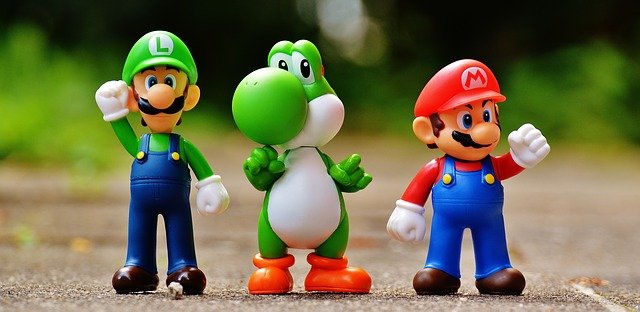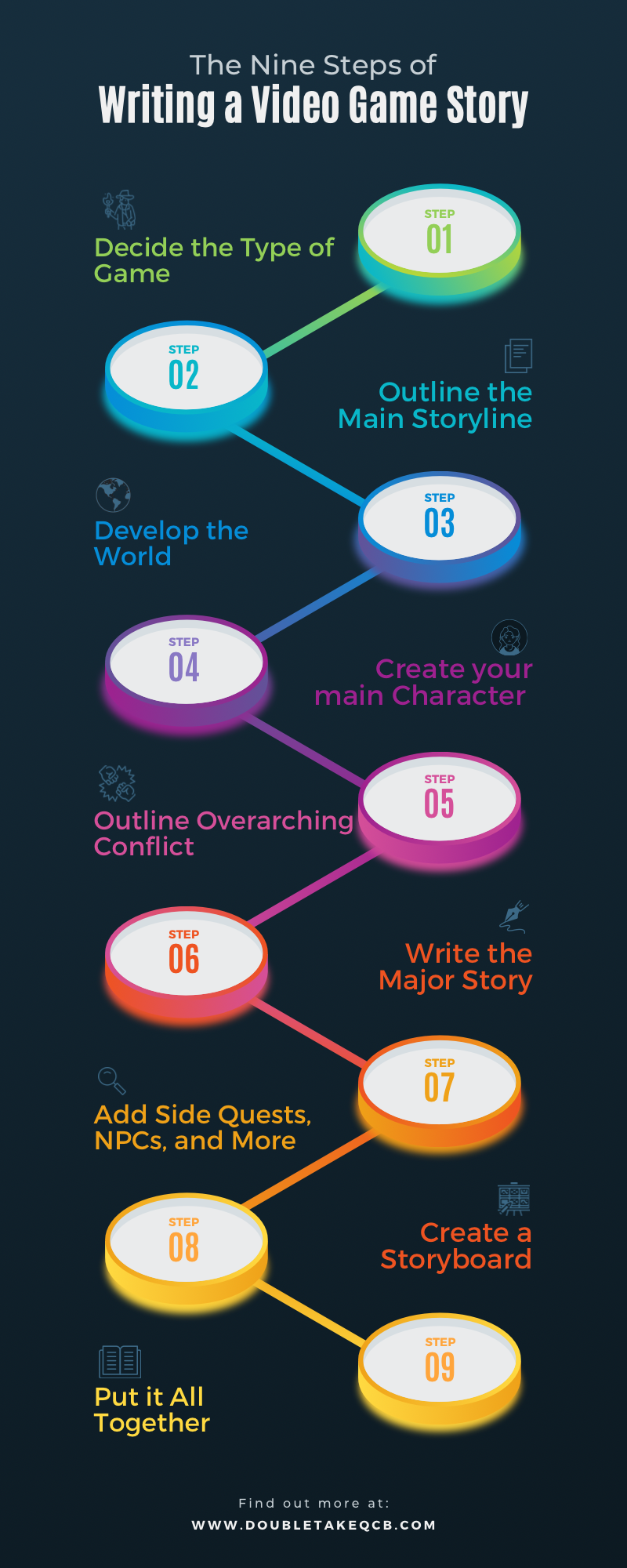
Write a Video Game Story
Video games have always been popular and I believe they have become even more so in the last few years. But what makes a good game? A lot would say the story does.
What Makes a Good Video Game Story
Video games possess so many features: combat, world, mechanics, interactivity and more; but what makes a good video game story? Well, it’s you who determines a good video game story. You who determines whether the story, mechanics, side plots and more are up to par. A few things that stands out despite your preferences, one that every video game has and must consider… is the player-character dynamic.

As you and the character are one and the same, the character cannot do something the player doesn’t believe the character could do. They player has control and a good game give them the sensation that they are in the video game.
Interactive gameplay allows you as the character, to explore and interact with the game on a level that not other medium could ever accomplish.
The world itself, can be as complicated, spacious, or linear as you want. Your characters still have a place to explore, something new to discover and traverse through.
The last is the character itself. Whether a pre-created character or one the player can create, you’ll want to fine tune all the details for the character as possible.
Player-Character Dynamic
A good video game understands that there is a balance between the player physical abilities and the abilities of the character on the game. The player is never to think that their character would never do one thing or another because it would be unrealistic. As the characters move along their journey, the player is privy to every aspect of their life, nothing comes as a shock nor is it a mystery to them.
Many games will use other means to create an easier balance between character and player, such as amnesia or inserting backstory clips which take away from the overall dynamic of the game.
Interactive Space to Explore
Though the level of interactivity within each game varies, every video game should offer some form of it. If not, then it’s just a very long movie in a video game format. The land or world in which you can explore either by choices, this or that; or by roaming freely throughout the game world, picking up nearly everything and discovering every inch of the map.
Players love to be able to interact with the world around them as their characters do. It’s best to keep that in mind as you’re writing your game.
World Building
This is where your character(player) will be spending all of their time within the game. It’s important that you have a world that compliments the characters and vice versa. Decide the major aspects of your world, it’s culture, systems and more as you work through the steps below.
The Character
Your player and your character are one and the same. Keeping that in mind as you build your character will help you to integrate them into your created world with ease. You and the player know your character and the player learns as the character does, not before or after.
How to Write a Video Game Story
These steps will take time to complete, it’s not as simple as completing each step in one day. These steps will give you a guideline to follow as you progress to writing your first video game story. Start by providing a broad overview of the story and then narrowing it down to be more specific until you have the final story. Don’t forget to keep the items mentioned above in mind!

Note: Before we dive in I want to mention one thing – If you are anything like me an the main character comes to you at any time during this process, pause and jot somethings down, but don’t go crazy getting off track. This will just help you later on when we get to your main characters.
Step One: Decide the Type of Game You Will Write
When deciding to write a video game story, you need to decide what type of video game you will write. Deciding whether your game will be a first-person shooter (FPS), a role-playing game (RPG), action-adventure, mystery puzzle, or another type of game will help you decide the basic layout for the next step. You can also have hybrids of any of those or other if you so choose. You decide what you want and go for it!
Step Two: Outline the Main Storyline.
Start out by outlining the main storyline. Use a large sheet of paper or poster or even post-it notes and use them to outline your story. Remember you are only working on the main story. We’ll get to the side stories in a bit.
Even though this is a very basic outline, you can add pieces, rearrange and continue until your story comes to life. It’s a great feeling when you see your outline take shape whether on poster board, a wall, a window or whatever else you have. Writers use whatever they have on hand, so too can you!
If your story has different endings, write them on a separate sheet of paper or post-its, but don’t add them in just yet. This is just so you don’t forget them as you go along. Once you’re outline is complete with the major plot points, it’s time to move on to the next step. Keep this handy as it will help save you from struggling later on.
Step Three: Develop the World
In this step you want to begin developing your game world whether it is a linear world or open world. This is what the player will be viewing the most of as they play the game, so working on this before working on your specific characters is essential.
In this step you will flesh out specific aspects of your game world, such as its culture, lore, setting, cities, landmark, and more. Be sure to flesh it out as much as possible as so when you get further in the planning process, you won’t be wondering about anything. Think about how much of the world your character will be able to explore and plan accordingly.
Step Four: Create Your Main Characters
Once your world is complete with notes and everything, it’s time to move onto your characters. This would include your most prominent characters: the main character, villains, companions (if applicable) and possibly those that affect the main story line.
It’s a good idea to follow those of writing a novel to flesh out your characters. Discover who they are, their backstories, likes, dislikes, pet peeves, favorite phrase and more. I have something for you to use when you click here!
Step Five: Outline the Overarching Conflict
This is where you will outline the story conflict. What conflict will happen throughout the game? How will it progress as the story moves forward? What characters are pitting against each other? What cities or towns are involved and more?
This is where all that conflict, internal and external, are outlined for the story to really take shape. It’s not a good story unless there is some conflict for your to defeat.
Step Six: Start Writing the Major Story
Look at this as the barebones version of your finished story. If you like you can start with just the cutscenes to provide a video like timeline of your story. This will give you what you need to see the entire story in one place. Focus on moving the story forward, revealing something of the character as the scenes move forward and keep the dialog simple. Players don’t want to be bogged down with paragraphs of dialog, they want to keep moving with the story.
Step Seven: Add in Side Quests, NPCs, and Other Small Details.
Now is the time you get to add in side quests and fill in your world with NPCs. Remember those alternative endings we mentioned earlier? This is where you plan how different players or choices achieve different endings.
Each of these has a different purpose within the game and may affect the characters you choose, where they are located in the game, and the mini journey that needs to be taken.
NPC – Non-Playable Characters are people your character interacts with. They may just offer their opinion, reveal information, or give hints. Others offer side quests and rewards for completing those side quests.
Side Quests – These can be world related, lore, or backstory related to one or more of your characters. They don’t have to affect the main plot at all, or they can be detrimental to the success of the mission.
Items – These are objects your character uses beyond weapons and armor. Notes, letters, food, and other items are a few examples and they help with quests or provide more information.
Step Eight: Create a Storyboard
Now your other creative side can come out to play. Create a storyboard of all your main points. Allow your story to come alive on the board, giving your teammates a visual of what your story should look like. This will also help you to see the story as a visual and not just in your head as bits and pieces.
Step Nine: Put it All Together
You are now ready to put all you’ve learned together into one cohesive game story. Create a massive outline, a mind map, typed pages or whatever you are comfortable with to get it your story together. The goal here is to make it easy for you to keep track and adjust as needed when you are in the process of making the actual game.
Once that is complete, you should be able to see the story as a whole allowing you to see any holes, errors, or any adjustments that need to be made.
What Do You Need to Write a Video Game
Here is a list of the things you’ll need to get started with writing your video game. These items will assist and create an easier time of creating your outlines, stories, storyboards and more.
- A team of experienced writer and artist, unless the scope of your game doesn’t require a team
- Experience playing video games – what better way to learn about video game stories than by playing video games to see them in action. Keep in mind the story as well as the game play element and mechanics.
- Writing software
- Google Docs, Pages, or Word
- Final Draft – Use for screenplays, but works well for video game scripts
- Twine – Write non-linear stories.
- Inklewriter – Alternative to Twine – Allows for a more interactive story.
- Outlines
- Character/World building guides/worksheets
- Storyboard worksheets or online at storyboardthat.com
Final Thoughts
That was a lot, but it helps to know what you need to write your story and get it fleshed out so you can move on to the creation of your game!
What type of game would you create if you were going to create one?
Chick the image below to download the infographic!








